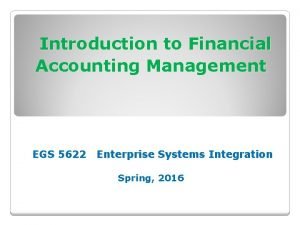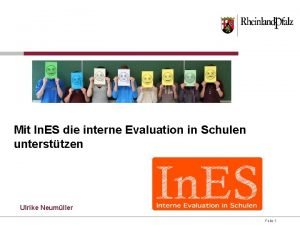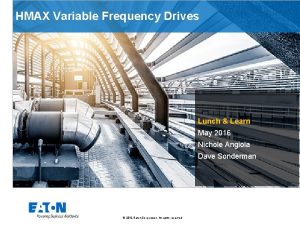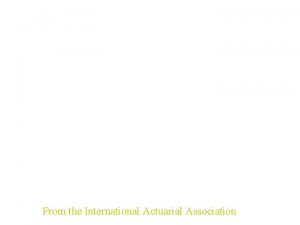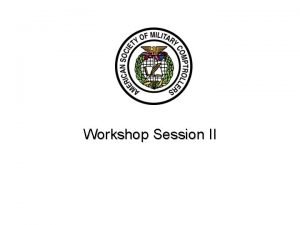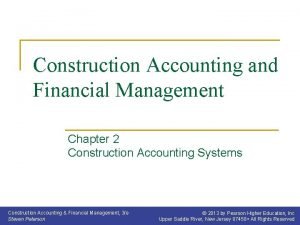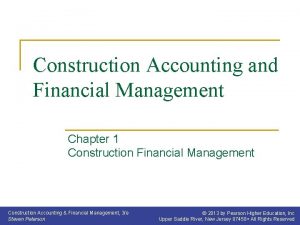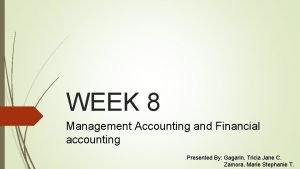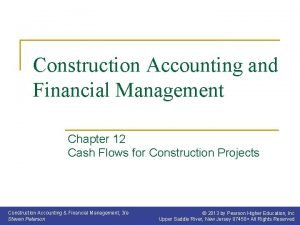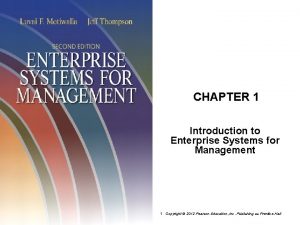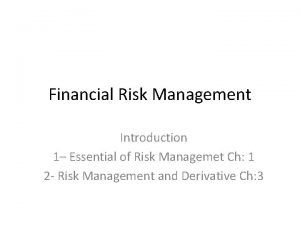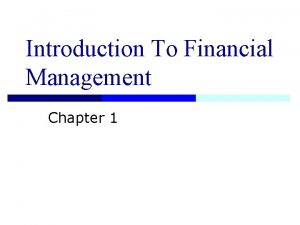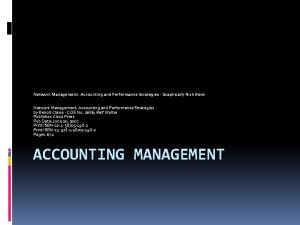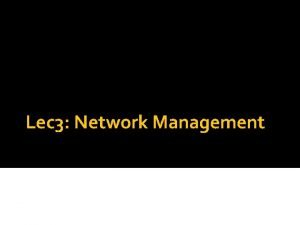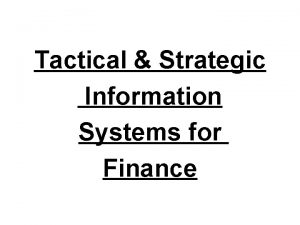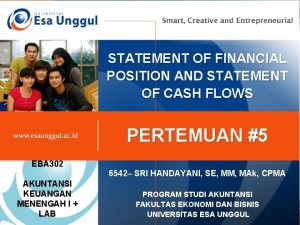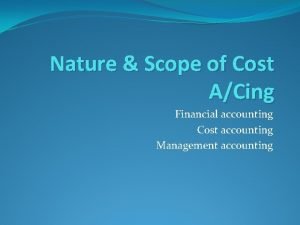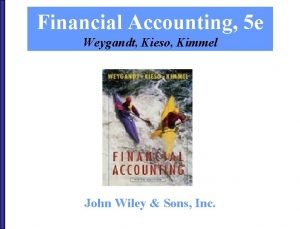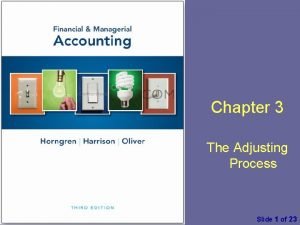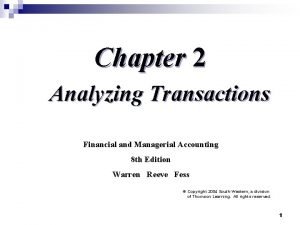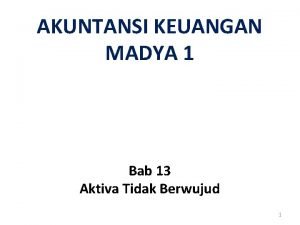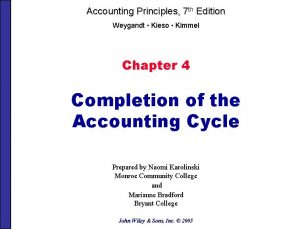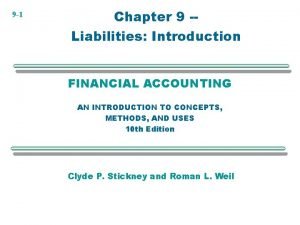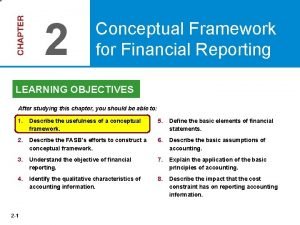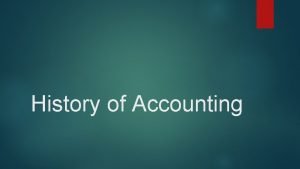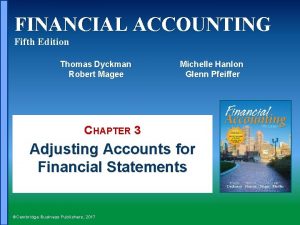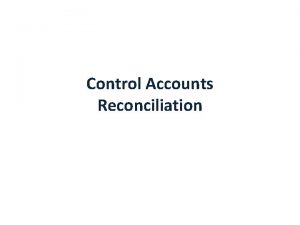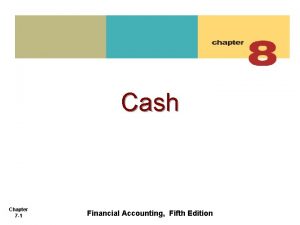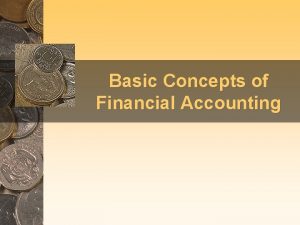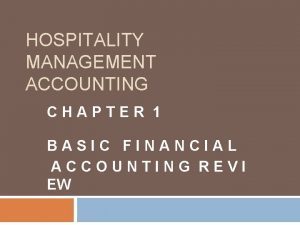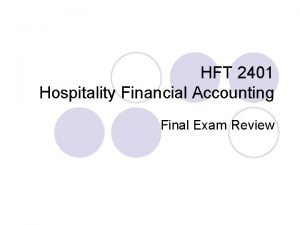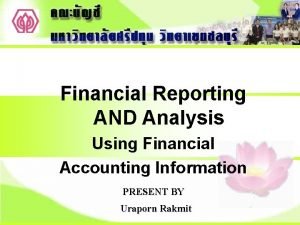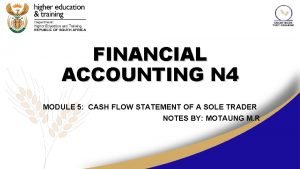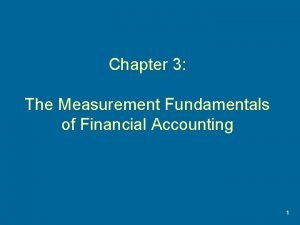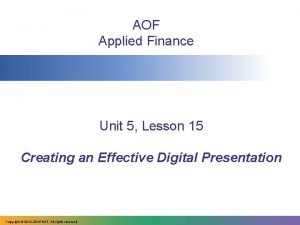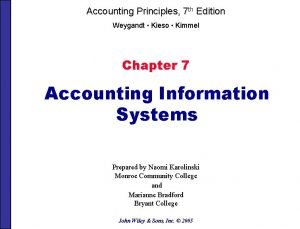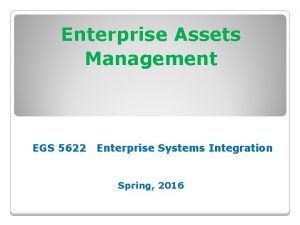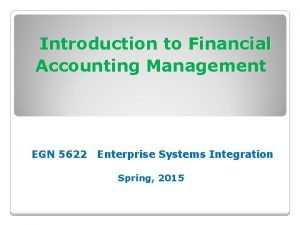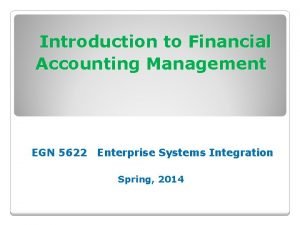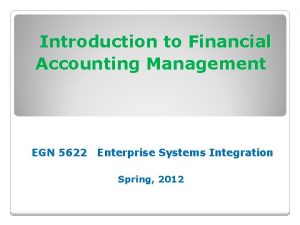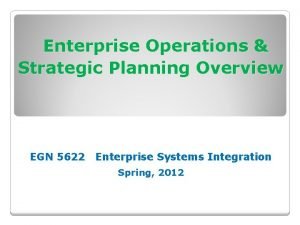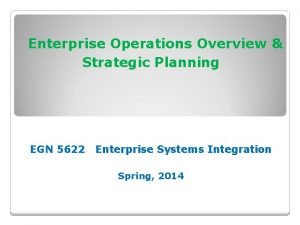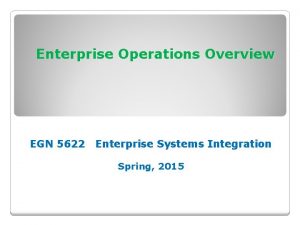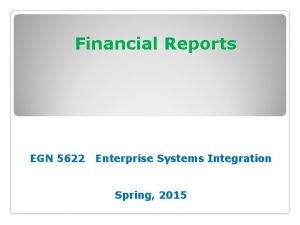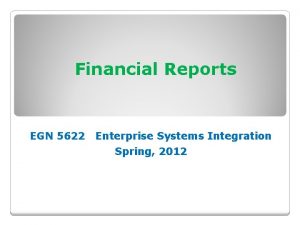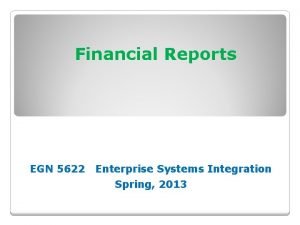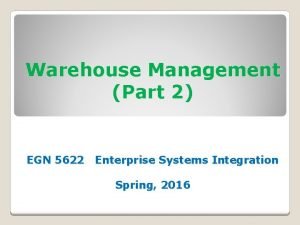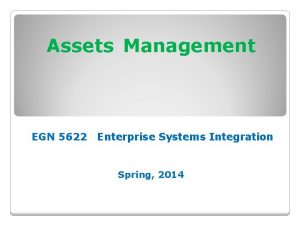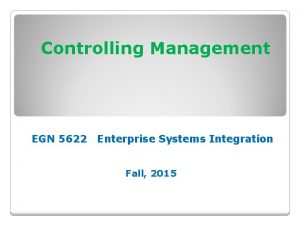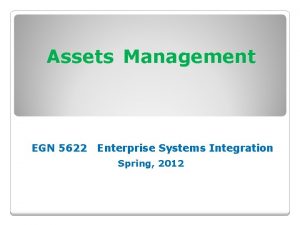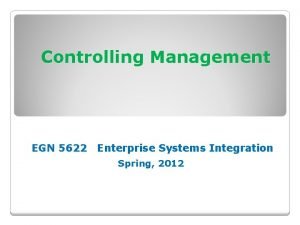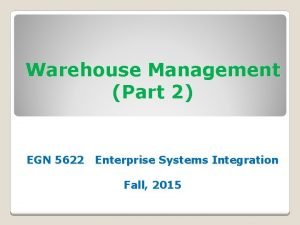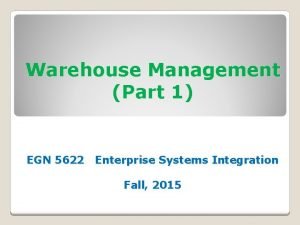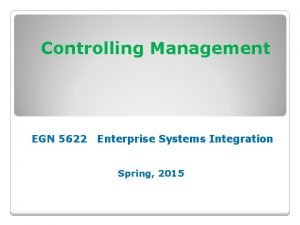Introduction to Financial Accounting Management EGS 5622 Enterprise
























































- Slides: 56

Introduction to Financial Accounting Management EGS 5622 Enterprise Systems Integration Spring, 2016

Introduction to Financial Accounting Management Theories & Concepts

Financial Accounting (FI) Financial accounting Designed to collect transactional data for preparing a standard portfolio of reports 3

FI Organizational Objects Represent enterprise legal and organizational views of an Form a framework to support business activities desired by the management Accurately collect and organize business information Enable and support business planning and decisions January 2007 (v 1. 0) © 2007 by SAP AG. All rights reserved. SAP University Alliance. The Rushmore Group, LLC 4

FI Organizational Objects Chart of Accounts ◦ It is a classification scheme consisting of a group of general ledger (G/L) accounts. ◦ It contains G/L accounts used by one or more company codes. General Ledgers (G/L) ◦ A unique combination of Company Code and Chart of Accounts used for preparing financial accounting statements ◦ Each G/L account with a unique account number is designated into a balance sheet account group and profit and loss account group. 5

Subsidiary Ledgers (Sub-ledgers) and Reconciliation Accounts Sub-Ledgers: Some financial data are not directly maintained in the general ledger. For example, customers accounts, which track the amounts customers owe and payments they paid, are maintained separately for each customer. Similarly, data about each vendor are maintained in separate accounts. Such accounts are called sub-ledgers, and don’t show up in the general ledger. January 2007 (v 1. 0) © 2007 by SAP AG. All rights reserved. SAP University Alliance. The Rushmore Group, LLC 6

Subsidiary Ledgers (Sub-ledgers) and Reconciliation Accounts Reconciliation accounts: Part of general ledger accounts that consolidate data from a group of related sub-ledger accounts, such as customers and vendors. The reconciliation account for customers is accounts receivable (A/R). The reconciliation account for vendors is accounts payable (A/P). Transaction data must be posted to subledger accounts, and then they are automatically posted to the corresponding © 2007 by SAP AG. All rights reconciliation account. reserved. SAP University January 2007 (v 1. 0) Alliance. The Rushmore Group, LLC 7

Subsidiary Ledgers (Sub-ledgers) and Reconciliation Accounts The balance in the reconciliation account (for example accounts receivable and accounts payable) is the sum of the postings in the related sub-ledger accounts (for example, customers and vendors, respectively). January 2007 (v 1. 0) © 2007 by SAP AG. All rights reserved. SAP University Alliance. The Rushmore Group, LLC 8

Vendor Accounts and A/P Vendor 100234 200 Vendor 100435 Accounts Payable (A/P) (General Ledger) 250 850 Vendor 100621 100 Vendor 100846 300 January 2007 (v 1. 0) © 2007 by SAP AG. All rights reserved. SAP University Alliance. The Rushmore Group, LLC 9

Customer Accounts and A/R Customer 189 100 Customer 142 Accounts Receivable (A/R) (General Ledger) 300 950 Customer 135 400 Customer 123 150 January 2007 (v 1. 0) © 2007 by SAP AG. All rights reserved. SAP University Alliance. The Rushmore Group, LLC 10

Accountants and Audit Trails Audit trails allow an auditor to begin with an account balance on a financial statement and trace through the accounting records to the transactions that support the account balance Audit trails enable an auditor to trace individual transactions to the effected account balance(s) on a financial statement January 2007 (v 1. 0) © 2007 by SAP AG. All rights reserved. SAP University Alliance. The Rushmore Group, LLC 11

Introduction to Financial Accounts Management SAP Implementation

SAP Module View Sales & Distribution Financial Accounting Materials Mgmt. Controlling Fixed Assets Mgmt. Production Planning Human Resources Quality Maintenance Integrated Solution Client / Server Open Systems Plant Management Project System Workflow Industry Solutions

Components of Financial Accounting Accounts Receivable Financial Accounting (FI) General Ledger Fixed Assets Accounts Payable Banks Special Purpose Ledger January 2008 © SAP AG - University Alliances and The Rushmore Group, LLC 2008. All rights reserved. 14

Business Processes Integration PP SD Data MM Master FI Rules Org Data FI MM PP SD FI FI MM MM PP PP SD SD January 2008 © SAP AG - University Alliances and The Rushmore Group, LLC 2008. All rights reserved. 15

Business Processes Integration § Financial Accounting (FI) § Materials Management (MM) § Sales and Distribution (SD) § Production Planning (PP) January 2008 © SAP AG - University Alliances and The Rushmore Group, LLC 2008. All rights reserved. 16

Integration Procurement Process (Procure-to-Pay) Purchase Requisition Purchase Order Notify Vendor Payment to Vendor Invoice Receipt January 2008 Vendor Shipment Goods Receipt © SAP AG - University Alliances and The Rushmore Group, LLC 2008. All rights reserved. 17

Integration Sales Order Process (Order-to-Cash) Check Availability Sales Order Entry Pick Materials Receipt of Customer Payment Invoice Customer Pack Materials Post Goods Issue © SAP AG - University Alliances January 2008 and The Rushmore Group, LLC 2008. All rights reserved. 18

Production Process (Make-to-Stock) Production Proposal (Planning/Other) Capacity Planning Integration Schedule and Release Shop Floor Documents Order Settlement Finished Goods Receipt Raw Materials Issue Completion Confirmation © SAP AG - University Alliances January 2008 and The Rushmore Group, LLC 2007. All rights reserved. 19

Financial Accounting Module Master Data FI Rules Org Data FI FI FI January 2008 © SAP AG - University Alliances and The Rushmore Group, LLC 2008. All rights reserved. 20

Financial Accounting Module Organization Master Data data Rules Transaction Data January 2008 © SAP AG - University Alliances and The Rushmore Group, LLC 2008. All rights reserved. 21

Financial Accounting Module - Organization Data Org Data FI FI January 2008 © SAP AG - University Alliances and The Rushmore Group, LLC 2008. All rights reserved. 22

Organizational Data A hierarchy in which the organizational units in an enterprise arranged according to functions and tasks They are static data and rarely changed Once the organizational structure is decided, it is not easy to change it The definition of organization units is a fundamental step; it is a critical factor in how the company will be structured 23

Optional Organizational Structures GM Corp. Chart of Accts Client GM–Corporate General Motors Credit Control Area Corporate Fiscal Year Var. Consolidation of Company Codes Chevrolet GMC Cadillac Business Areas Cars Trucks January 2008 © SAP AG - University Alliances and The Rushmore Group, LLC 2008. All rights reserved. 24

Enterprise Structure Client (640) Credit Control Area (GL 00) Business Area (BI##) Chart of Accounts (GL##) Purchasing Group (N##) Work center (ASSY/INSP/PAC K/MANT/SERV) Controlling Area (NA##) Company Code (US##) Purchasing Org. (US ##) Fiscal Year Variant (K 1) Cost centers Plants (DL##/MI##/SD##) FG## SF## Sales Org. (UW##/UE##) RM## MI## TG## Shipping Point (DL##/MI##/SD##) Distribution Channel (IN/WH) Division (BI/AS) Sales Area

Business Areas (review) Business Areas An enterprise organizational unit within financial accounting. It corresponds to a defined business segment or area of responsibility, to which you can assign value movements recorded in Financial Accounting. Business areas may also group product and market combinations as homogeneously as possible for the purpose of developing unified business policy. January 2008 © SAP AG - University Alliances and The Rushmore Group, LLC 2008. All rights reserved. 26

Financial Accounting Module - Master Data FI January 2008 © SAP AG - University Alliances and The Rushmore Group, LLC 2008. All rights reserved. 27

Master Data (review) Financial Accounting (FI) • General Ledger Accounts • Material Master • Vendor Master • Customer Master Material Management (MM) • Vendor Master • Material Master • Customer / Purchasing Info Records Manufacturing (PP) • Material Master • BOM • Routing • Work center • PRT (Production Resource/Tools) Sales & Distribution (SD) • Customer Master • Material Master • Pricing • Credit Limits • Customer Material Info Records • Item Proposal 28

FI Master Data January 2008 © SAP AG - University Alliances and The Rushmore Group, LLC 2008. All rights reserved. 29

General Ledger – Master Data General Ledger accounts are created at the client level A unique master record is created for each General Ledger account January 2008 © SAP AG - University Alliances and The Rushmore Group, LLC 2008. All rights reserved. 30

Financial Accounting Module FI Rules FI January 2008 © SAP AG - University Alliances and The Rushmore Group, LLC 2008. All rights reserved. 31

Rules (Review) Defines the parameters for Master Data and Transactions Determines functionality for Master Data and Transactions Relatively Changes fixed as policy changes January 2008 © SAP AG - University Alliances and The Rushmore Group, LLC 2008. All rights reserved. 32

Rules Financial Accounting • Account Groups • Field Status Variant • Fiscal / Posting Periods • Tolerance Groups • Document Types • Number Ranges • Automatic Account Assignment • Valuation Area Grouping • Parameter IDs Material Management • Fiscal Periods • Account Groups • Material Types • Plant Parameters • Purc. /Rec. /Inv. Tolerances • Automatic Account Assignment • Reservations • Material Group • Loading Group January 2008 Sales & Distribution • Account Groups • Pricing Procedure Determination • Shipping Point Determination • Revenue Account Determination • Define Availability Check • Define Credit Check • Document Types © SAP AG - University Alliances and The Rushmore Group, LLC 2007. All rights reserved. 33

An Example for Account Groups in GBI Chrt/Accts GL## Acct Group BS GL## FA LA MA PL GL## RA January 2008 Name From acct To account ## Balance Sheet Accounts ## Fixed Assets ## Liquid Assets ## Material Accounts ## Profit & Loss Accounts ## Reconciliation Accounts 100000 399999 220000 100000 200000 400000 300000 101999 200600 999999 110000 310000 © SAP AG - University Alliances and The Rushmore Group, LLC 2008. All rights reserved. 34

Account Groups Control which fields must be entered when an account is created Determine a valid number interval for each of the groups (types) of General Ledger accounts that have common attributes Must be created before General Ledger Accounts master records can be created You must assign each account to an appropriate account group January 2008 © SAP AG - University Alliances and The Rushmore Group, LLC 2008. All rights reserved. 35

Financial Accounting Module FI January 2008 © SAP AG - University Alliances and The Rushmore Group, LLC 2008. All rights reserved. 36

Transaction Data Includes transactions that describe business activities Unlike master data, aggregate transactional data is dynamic - it constantly changes, usually many times per day – each transaction is unique Transactions use organizational structure, master data, and rules January 2008 © SAP AG - University Alliances and The Rushmore Group, LLC 2007. All rights reserved. 37

Transaction Overview Document Principles Document Types Posting Keys Invoice Receipt Invoice Entry Account Payable Process Account Receivable Process January 2008 © SAP AG - University Alliances and The Rushmore Group, LLC 2008. All rights reserved. 38

Document Principles Each completed accounting transaction writes data to the database and creates a unique electronic document A financial accounting document records the impact (either debit or credit, and in which account) of a transaction step on financial accounting Each document contains information such as: ◦ Responsible person ◦ Date and time of the transaction ◦ Commercial content including company codes January 2008 © SAP AG - University Alliances and The Rushmore Group, LLC 2008. All rights reserved. 39

Document Types A way to categorize different transactions ◦ Many different document types are supplied in the system A document type is two-digit code that identifies the specific business process Document types are associated with number ranges ◦ All documents of the same document type are stored in the system by document number Determine posted to the type of account that can be January 2008 © SAP AG - University Alliances and The Rushmore Group, LLC 2008. All rights reserved. 40

Document Types – (continued) Common used document types: SA – General ledger account documents DR – Customer invoices DG – Customer credit memos DZ – Customer payments KR – Vendor invoices KG – Vendor credit memos KZ – Vendor payments KN – Vendor net invoices and credit memos WA – Goods issue WE – Goods receipt January 2008 © SAP AG - University Alliances and The Rushmore Group, LLC 2008. All rights reserved. 41

Document Numbers All posted transactions must have a unique number assigned to it Usually these numbers are system generated The numbers serve to specifically identify the business content of a transaction so that it may be recalled at a later time The actual system stored document number includes information respecting the year, date, and company codes January 2008 © SAP AG - University Alliances and The Rushmore Group, LLC 2008. All rights reserved. 42

Posting Keys Posting key (PK) has a control function that pertains to the document line items. It determines the following: • Account type for posting the line item • Debit or credit posting of line items • Field status for additional information Account Types: D – Customer K – Vendor A – Assets M – Material S – G/L Accounts January 2008 © SAP AG - University Alliances and The Rushmore Group, LLC 2008. All rights reserved. 43

Accounting Document (-continued) Posting Key Examples: Posting Key Debit/Credit Account Type 40 (debit) 50 (credit) Debit Credit G/L account 31 (invoice) 25 (payment) Credit Debit Vendor 89 (Stock In) 99 (Stock out) Debit Credit Material 01 (invoice) 15 (payment) Debit Credit Customer 44

Posting Keys – (continued) General Ledger 40 50 Vendors Common Posting 25 31 Keys Assets 70 Material 75 89 Customers 99 01 January 2008 15 © SAP AG - University Alliances and The Rushmore Group, LLC 2008. All rights reserved. 45

Accounts Payable Process Purchase Order Payment Program Debit Credit Invoice Receipt Verification Goods Receipt January 2008 © SAP AG - University Alliances and The Rushmore Group, LLC 2008. All rights reserved. 46

Goods Receipt / Invoice Receipt Reconciliation Account Purchase requisition Purchase order No impact on Financial Accounting (FI) Materials Management (MM) and Financial Accounting (FI) via automatic account assignment Goods receipt Inventory GR / IR Dr Dr $100 Cr Cr $100 January 2008 © SAP AG - University Alliances and The Rushmore Group, LLC 2008. All rights reserved. 47

Goods Receipt / Invoice Receipt Reconciliation Account Amount owed is assigned and transferred to vendor account payable Invoice receipt GR / IR Dr Cr Vendor (sub-ledger) Dr Cr $100 A/P Dr Cr $100 January 2008 © SAP AG - University Alliances and The Rushmore Group, LLC 2008. All rights reserved. 48

Vendor Payment Amount owed is paid to vendor and account payable is reduced Bank Dr Cr Vendor (sub-ledger) Dr Cr $100 A/P Dr Cr $100 January 2008 © SAP AG - University Alliances and The Rushmore Group, LLC 2008. All rights reserved. 49

(FI – MM) Integration Points Goods Receipt Inventory Dr $100 Invoice Receipt Payment Program (Vendor) GR / IR Cr Dr $100 Cr $100 Dr Bank Cr $100 Dr $100 Cr $100 A/P Dr Cr $100 January 2008 © SAP AG - University Alliances and The Rushmore Group, LLC 2008. All rights reserved. 50

Accounts Receivable Process Sales Order From customer Post Payment Issue Goods Issue Invoice January 2008 Debit Credit © SAP AG - University Alliances and The Rushmore Group, LLC 2008. All rights reserved. 51

Goods Issuing Reconciliation Account No impact on Financial Accounting (FI) Sales quotation Sales order Materials Management (MM) and Financial Accounting (FI) Delivery/Goods Issuing Inventory (Trading, F/G) Dr Cr $1, 000 COGS Dr $1, 000 Cr

Billing Reconciliation Account Billing Sales Revenues Dr Cr $1, 250 Billing amount is assigned and transferred to customer account receivable Customer (sub-ledger) Dr Cr $1, 250 Account Receivable (AR) Dr $1, 250 Cr

Customer Payment Amount is paid by Customer and account receivable is reduced Customer (sub-ledger) Dr Cr $1, 250 Account Receivable (A/R) Dr Cr $1, 250 Bank Dr Cr $1, 250

(FI – SD) Integration Points Goods Issue Inventory (F/G) Dr Cr $1, 000 Payment Program Billing (Customer) COGS Dr Cr $1, 000 Dr Cr $1, 250 Bank Dr Cr $1, 250 Revenue Dr A/R Cr $1, 250 Dr Cr $1, 250 January 2008 © SAP AG - University Alliances and The Rushmore Group, LLC 2008. All rights reserved. 55

Exercises: (Due date: 2/10/2016) 1. Display chart accounts 2. Run financial statements 3. Post transfer of funds to bank account 4. Post transfer of funds to new bank account 5. Create vendor master record for landload 6. Create invoice receipt for rent expense 7. Display & review GL accounts and individual line items 8. Display & review accounts payable balances and individual line items 9. Post payment to landlord 10. Display & review accounts payable balances and individual line items 11. Create cost element for expense account 12. Post purchase of operating supplies 13. Run financial statements 14. Create purchase order 15. Create goods receipt 16. Post invoice receipt from vendor 17. Post payment to vendor 18. Run balance sheet/profit and loss statements
 Egs accounting
Egs accounting Advanced corporate accounting ppt
Advanced corporate accounting ppt Apec environmental goods
Apec environmental goods Egs.bildung-rp.de
Egs.bildung-rp.de Kaic calculator
Kaic calculator Intermediate accounting chapter 1
Intermediate accounting chapter 1 Enterprise risk management for financial institutions
Enterprise risk management for financial institutions Defense enterprise accounting and management system
Defense enterprise accounting and management system Construction accounting and financial management
Construction accounting and financial management Introduction to construction financial management
Introduction to construction financial management External users of accounting information
External users of accounting information Construction accounting and financial management
Construction accounting and financial management Introduction to enterprise management system
Introduction to enterprise management system Putting the enterprise into the enterprise system
Putting the enterprise into the enterprise system Enterprise
Enterprise Financial risk management introduction
Financial risk management introduction Introduction to financial management
Introduction to financial management Accounting management in network management
Accounting management in network management Introduction to network management
Introduction to network management Accounting management in network management
Accounting management in network management Non-financial motivators
Non-financial motivators What is tactical information system
What is tactical information system Statement of financial position classification
Statement of financial position classification Management accounting scope
Management accounting scope Scope of cost accounting
Scope of cost accounting Management accounting nature and scope
Management accounting nature and scope Kimmel accounting 5th edition
Kimmel accounting 5th edition Income statement in financial accounting
Income statement in financial accounting Managerial accounting chapter 2 solutions
Managerial accounting chapter 2 solutions Unit 5 lesson 2 financial accounting
Unit 5 lesson 2 financial accounting Unit 5 lesson 2 financial accountings
Unit 5 lesson 2 financial accountings Financial accounting chapter 13
Financial accounting chapter 13 Equity accounted investments
Equity accounted investments Kimmel financial accounting 7the edition
Kimmel financial accounting 7the edition Financial accounting chapter 9
Financial accounting chapter 9 The conceptual framework that underlies ifrs
The conceptual framework that underlies ifrs Is luca pacioli a cpa
Is luca pacioli a cpa Financial accounting dyckman
Financial accounting dyckman Contra entry in control accounts
Contra entry in control accounts Financial accounting kimmel ch1-2
Financial accounting kimmel ch1-2 Financial accounting chapter 7
Financial accounting chapter 7 Basic concepts of financial accounting
Basic concepts of financial accounting Importance of financial accounting
Importance of financial accounting Unit 13 accounting and financial statements
Unit 13 accounting and financial statements Financial accounting ifrs 4th edition chapter 12
Financial accounting ifrs 4th edition chapter 12 Objective of financial accounting
Objective of financial accounting Cost of goods manufactured formula
Cost of goods manufactured formula Hospitality accounting basics
Hospitality accounting basics Hft accounting
Hft accounting Using financial accounting information 10th edition
Using financial accounting information 10th edition Cash flow structure
Cash flow structure Financial accounting chapter 3
Financial accounting chapter 3 Owner's equity statement
Owner's equity statement Appendix g financial accounting
Appendix g financial accounting Unit 5 lesson 2 financial accounting
Unit 5 lesson 2 financial accounting Kimmel financial accounting 7e
Kimmel financial accounting 7e Materiality constraint example
Materiality constraint example
